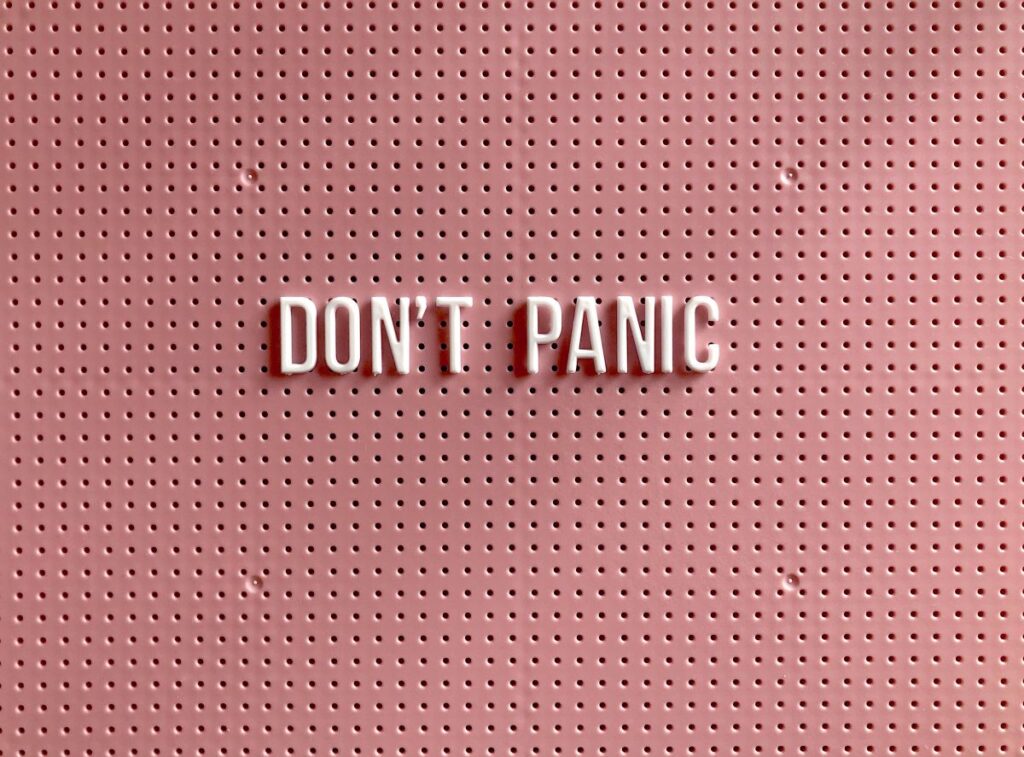
My chest tightens, heart races, palms sweat, eyes flicker around the room and my thoughts begin to run wild. This used to be commonplace for me when taking the tube, meeting friends or even going to the shop to buy milk. I’ve learnt to manage my anxiety and now am fortunate enough to work in secondary mental health services supporting others to manage and thrive with different mental illnesses.
So, let’s get into it. Anxiety is a common experience that can be a motivating force when facing challenges, a warning sign to bring awareness to a current situation and usefully the fight-or-flight response allowing us to react faster to threat. Generalised anxiety disorder on the other hand no longer serves a motivating purpose and starts to become detrimental and distressing in daily life. This is commonly characterised by reductions in physical, emotional and social functioning (Penninx et al, 2021).
I don’t mean to make this about the burden on the healthcare system, because that feels cold and calculating, but it’s a fact in our current climate that services are overstretched; there’s not enough funding and policies of austerity make it hard to do the job. Generalised anxiety impacts the healthcare system in many ways including primary and acute visits as well as personal and societal costs associated with missed work and opportunities (Konnopka and Konig, 2020), and it’s important we understand the best evidence in terms of its epidemiology and treatment, to be most effective in targeting the resources we do have.
We know the headline figures on general rates of anxiety in the UK. What has been missing has been good data from primary care (where most people with anxiety first seek help) and exploration of any changes over recent times. It has been commonly said in the media that we are living in more anxiety provoking times, but is that really true, and is it hitting everyone in the same way? A recent paper by Slee et al. (2021), published in the British Journal of Psychiatry, looks at temporal changes in recording of generalised anxiety in primary care and initial pharmacologic treatments.

Anxiety: it’s common, it’s frequently debilitating, and it’s on the rise. This new research looked at temporal changes in recording of generalised anxiety in primary care and initial drug treatments.
Methods
In order to obtain relevant data, The Health Improvement Network (THIN) took data from 795 general practitioner practices. This makes it the largest and most recent assessment of time trends for general anxiety in general practice. THIN allows GPs to enter medical diagnoses and symptoms, cross link them to the ICD diagnosis system (international standard for reporting diseases and health conditions) and ultimately record clinical findings. Prescriptions are also recorded. This is interesting: this covers a diverse range of primary care practices that in turn provides care to a breadth of people across the UK (the authors estimate 6% of the country). Practices aligned to the THIN database code for everyone they see, so we can be relatively confident the sample is representative. The link to ICD10 codes helps ensure consistency, albeit that diagnoses in mental health can be a contentious topic in their own right.
Records from 1 January 1998 to 31 December 2018 were used (confirming trends on the back of a previous study from 1998-2008).
- People born in or after 1910 were selected
- Cohort entry occurred when patients were at least 18 years of age
- Patients had to be registered with their GP for at least 12 months
- GPs met pre-specified quality standards through the use of Acceptable Computer Usage (ACU)
- People with a diagnosis of generalised anxiety disorder, generalised anxiety symptoms, depression, depression symptoms or mixed anxiety and depression before cohort entry were excluded.
Prescription identification
The authors collected data on prescribed medications for depression and anxiety, these were analysed and classified according to the British National Formulary coding (BNF 2021).
Statistical analysis
The data was analysed using a Poisson mixed effects model to fit the counts of diagnosis of generalised anxiety or generalised anxiety symptoms. This is a type of regression analysis that allows the estimation between a ‘dependent variable’ (here the rates of anxiety) and ‘independent variables’ that might impact it (for example age or gender).
The prescription drug analysis was to determine prescribing trends for generalised anxiety.
Results
For the 6,630,040 people who met the inclusion criteria for this analysis the following results were found:
- 400,667 met the criteria for generalised anxiety diagnoses, and out of these:
- 8% had a generalised anxiety disorder
- 8% had generalised anxiety symptoms only
- 4% had both a generalised anxiety diagnosis and generalised anxiety symptoms
Fitting with other data on the topic, the rate of generalised anxiety diagnoses was higher for women compared with men across all age groups.
However, the unique design allowed unpicking of the two critical findings. Between 2014 and 2018 there were sharp increases in anxiety conditions for younger individuals, aged 18-24 years and 25-34 years, in both male and female. Concerningly, this was particularly pronounced in young women. The increase among women aged 18-24 years was about twice the increase for the next youngest cohort of women and for the youngest group of men.
The generalised anxiety rates among individuals aged >55 were largely unchanged and in fact slight decreases over time in generalised anxiety rates were found in this group.
Medication
Among individuals who had not been taking any psychotropic medication before receiving a generalised anxiety diagnoses, about half were given drug treatment in the first year.
There has been a slight increase in the proportion receiving medication since about 2006. The relative proportion prescribed medications who received SSRI antidepressants has increased steadily over the study period which is in line with NICE guidelines treatment [CG113] (NICE 2019). In parallel, the rates of benzodiazepine use began decreasing around 2008, and continued through to 2018, which is in line with concerns around the addictive nature of such medication for many (Lembke, Papac & Humphreys, 2018).

This paper found that the rise in anxiety is unequal: young women are the most impacted.
Conclusions
The results provide the largest and most recent data set for anxiety within the UK and give a clear account of trends over time. This paper highlights the disproportionate impact for women, particularly those within the age group 18-24. This may be linked to some of the following; sense of safety (or lack of it), societal pressure, double standards, use of social media and much more.
These authors also considered that GP attitudes may be changing, and decreased stigma and better awareness might partially account for some of the increase noted. However, they queried how this would plausibly explain the disproportionate increase within younger adults.
On reading this paper I considered the medication aspect to be of particular interest, with an SSRI treatment being given to 50% of patients within the first year of a diagnosis. Although this is a frontline treatment, I am curious as to whether this is due to GP hesitancy around self-managed anxiety, or perhaps a ‘quick’ or ‘simpler’ fix; also, we are all aware of the often long waiting times for talking therapies. On the one hand, medications are evidence-based, can yield good results and are cost efficient. On the other hand, are we too readily reaching for medications without teaching and supporting people to manage their mental health through alternative means? I have found that services are sometimes too stretched to offer support quickly enough to abate crises for those new to mental health services and if I can speculate, this could be at times extended to primary care services.

Are we too readily reaching for medications without teaching and supporting people to manage their mental health?
Strengths and limitations
This data is taken from people who actually seek help from their general practitioners, making it impossible to encapsulate those who don’t seek help from their GP. This fits in with the broader narrative that women find it easier to ask for help, whereas men are less likely to explore mental health issues with their GP.
The research found some evidence of hesitation of the GPs to record generalised anxiety disorders even when suspected clinically, and instead reported generalised anxiety symptoms. This reluctance could be extended to consider that there is another group presenting with generalised anxiety symptoms, which are not even recorded. This raises the question of thresholds in our current climate.
A further limitation was that the analysis did not account for other anxiety disorders such as panic disorder, obsessive-compulsive disorder and social phobias. The analysis did also not account for concurrent substance misuse, which is sometimes comorbid with anxiety disorders, but is often poorly coded in general practice.

This study does not take into account those who don’t seek help from their GP for anxiety symptoms. Could this be the explanation for the seemingly greater rates of anxiety among young females who are more likely to seek help?
Implications for practice
The poem ‘Be A Lady They Said’ written by Cammile Rainville and performed by Cynthia Nixon springs to mind when trying to describe the immense pressure placed on us as women (Girls. Girls. Girls. Magazine, 2020). In the lead author’s opinion, the challenge to simultaneously complete so many ridiculous requests at one given time is enough to make any woman anxious, let alone young women who are discovering this all within the age of social media.
Within my professional practice, I would nevertheless caveat this, highlight my own experience in secondary mental health services responding to crises on duty, with men often seeming to present initially in crisis with minimising behaviour, poorer understanding of mental illness than women and more intense feelings of shame and fear. I have found, particularly with men, that normalising and validating cannot be underestimated when they begin to disclose symptoms and reach out for help. This intervention can be done at any level and simply highlights that stigma still dictates people’s willingness to engage with services.
As the paper looks at data from 1998-2018, I am curious to see the effects that the Coronavirus pandemic has had on everyone’s experience of anxiety, whether the anxiogenic times have impacted us greatly, or whether internal and societal resilience will surprise us. Either way, it’s been, and continues to be, a difficult time to be experiencing or working within mental health.

“The challenge to simultaneously complete so many ridiculous requests at one given time is enough to make any woman anxious, let alone young women who are discovering this all within the age of social media”.
Statement of interests
The authors have no conflict of interests.
Links
Primary paper
Slee, A., Nazareth, I., Freemantle, N., & Horsfall, L. (2021). Trends in generalised anxiety disorders and symptoms in primary care: UK population-based cohort study. The British Journal of Psychiatry, 218(3), 158-164.
Other references
Girls. Girls. Girls. Magazine (2020) Be a Lady They Said. Accessed: 28 February 2021.
Konnopka A, Konig H. (2020) Economic burden of anxiety disorders: a systematic review and meta-analysis. Pharmacoeconomics, 2020; 38:25-37
Lembke, A., Papac, J. and Humphreys, K. (2018) Our other prescription drug problem. The New England journal of medicine, 378(8).
National Institute for Health and Care Excellence (2019). Generalised anxiety disorder and panic disorder in adults: management Clinical guideline [CG113], 2019.
Penninx BWJH, Pine DS, Holmes EA, Reif A. (2021) Anxiety disorders, The Lancet; 397:914-927
Photo credits
- Photo by Stephan Henning on Unsplash
- Photo by Tonik on Unsplash
- Photo by Cortney White on Unsplash
- Photo by little plant on Unsplash
- Photo by Priscilla Du Preez on Unsplash
- Photo by Firmbee.com on Unsplash
